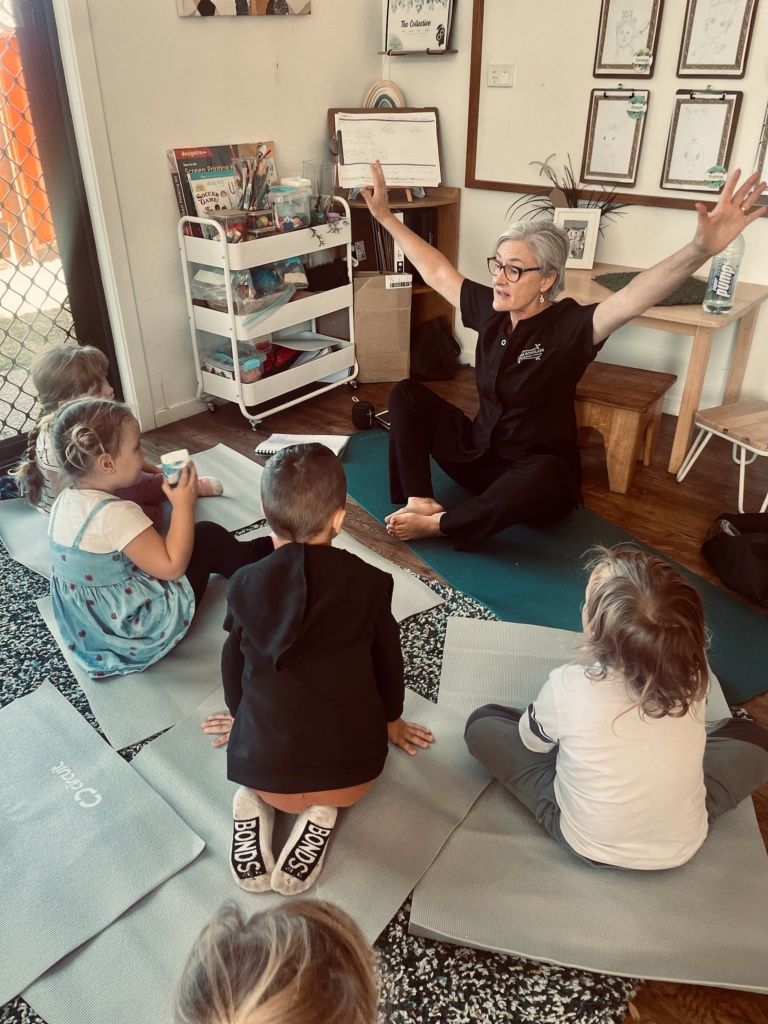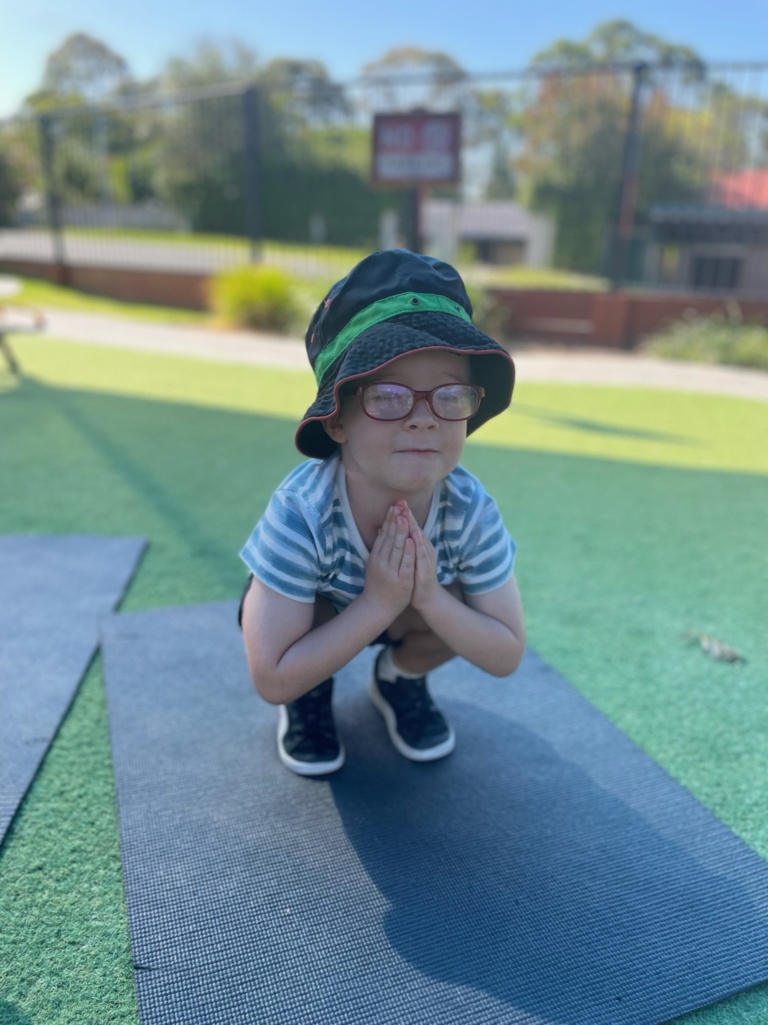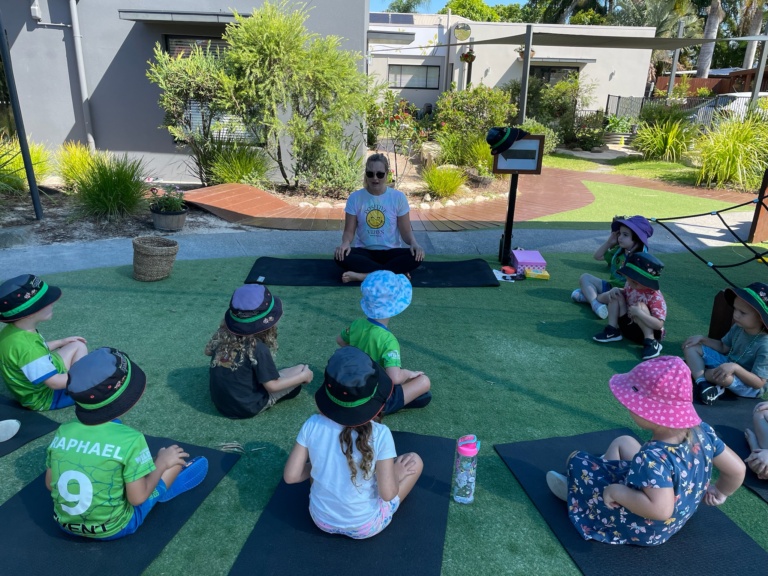These days, life feels busier, more rushed, more overwhelming, so the need for bringing calm into our bodies and minds has never been more welcome.
We introduced our Little Scholars Mindfulness Program back in 2021, a time when the world was chaotic, and the early learning sector was facing its own unique challenges. While thankfully we’ve moved through that period and the world has adjusted, the importance of mindfulness, yoga, and meditation in early learning remains significant. These practices continue to play a crucial role in helping children develop focus, emotional resilience, and a sense of inner peace that supports their overall growth and wellbeing. But that’s not all these practices offer children.
We’ll share all the benefits mindfulness practices provide children, and we get to speak with Annette Hartland, a former Little Scholars educator who now teaches yoga and meditation full time to young children, including our little scholars.

Annette once worked as an educator in our Ashmore campus, leaving to follow her passion of becoming a yoga instructor. However, achieving her dream meant she actually returned to us in a different capacity, she now leads yoga and meditation practice at several of our campuses and our support office.
We asked Annette how she got started practicing yoga, and what she saw as the benefits of mindfulness practices for children.
How did you get involved in yoga and what is it like to mix your passion for yoga with your great affection for young children?
It’s been so long that I don’t remember a time in my life when I haven’t practised some type of yoga/meditation. The short story is that my sister asked me to attend classes with her just after my second child was born. I’ve attended regularly ever since. My daughter’s almost 30 years old! Cliche as it sounds, Children are the future. They are inquisitive, flexible in mind and body and are ready to learn. It is vital to nurture this love of learning and develop a discipline of moving within their own space and taking time to be calm and think.
What are the emotional benefits of the practice?
Yoga and meditation practice take you inside yourself to be more aware of the movement of your breath, your body and your mind. We use the breath to be able to deal with situations calmly. One deep inhalation and a long exhalation remind us to pause to consider all the possibilities. Yoga teaches that all living beings are connected. This has a positive benefit for all living creatures. The children feel the difference between moving, being still and being relaxed.
What are the physical benefits?
Move it or lose it is the simplest answer. Children become aware of how much space they like at particular times eg. resting by themselves, partner poses, time to move with wide arms and stance or just a little space around their body. They develop concentration to maintain balance, they strengthen their muscles and become more flexible. We love moving rigorously and then freezing – the difference between effort and ease, mobile and relaxed.
What have you witnessed after teaching yoga with the children?
After teaching certain breathwork or postures, which I learned through the Zenergy yoga therapy course, the children settle more easily and are able to participate with more awareness. Some children are more aware of others and volunteer to be giving of themselves.
Do you have any advice for parents on bringing more mindfulness at home?
Take the time to be present to your children for a while each day, at least 10 minutes. No TV or telephones or music – just you and your child. Take a walk in nature, gaze at the stars, sit with a pet, cuddle on the couch and chat or be silent or breathe together. Listen, smell, taste, touch, feel … connect. This makes precious memories with your children.

As mentioned, one facet of our mindfulness program is offering our little scholars yoga sessions delivered by experts like Annette, and as she says, yoga offers a multitude of benefits for emotional and physical development, backed by research.
On the physical side, yoga enhances flexibility, coordination, balance, and posture. Yoga requires our full attention, requiring us to focus on the present and be fully aware of what our body is doing at any one time. It also helps develop fine and gross motor skills, guiding us to learn to control breathing, our stance and where we’re putting our weight, and flowing through to the next posture.
On the emotional side, by focusing on movement, balance, breathing and everything else that yoga requires of us means that we’re fully present in the moment, practicing self-awareness and mindfulness, reducing stress and any outside ‘noise’, promoting relaxation, bringing a sense of calm and wellbeing. In turn, this means we’re developing emotional regulation and resilience.
For children who are just learning how to interpret and manage their emotions, this is a fantastic way for them to deal with life’s challenges big and small.

Another and even easier way to bring more mindfulness to our day-to-day that anyone, including children, can do is practice breathing techniques to calm the mind and body. Here are some of our favourite breathing techniques for children.
1. Ask children to lie on the floor and place a small object, such as a soft toy or bean bag on their belly. Get them to place their hands by their side and breathe normally, watching the object go up and down. You could count as they inhale and exhale ‘breathe in 1, 2, 3, breathe out 1,2,3.’
2. Print or cut out some square, rectangle or triangle shapes and give one to each child. Ask the children to trace their finger around the shape, breathing in while moving their finger along one edge of the shape, hold their breath for a few seconds before breathing out, while tracing around the next side of the shape. Repeat this a number of times.
Children can also use their own hand as the shape, using a finger on the other hand to trace up the side of a finger while breathing in and down the other side of the finger while breathing out, before moving on the next finger.
3. While sitting comfortably, model for the children how to create a circle shape with their hands and ask them to imagine that inside the circle is a mug of hot chocolate. Ask the children to breathe in slowly to smell the hot chocolate, and then blow out slowly to cool it down, repeating this a number of times.
Yoga for Children and Young People’s Mental Health and Well-Being: Research Review and Reflections on the Mental Health Potentials of Yoga: Ingunn Hagen and Usha S. Nayar, Department of Psychology, Norwegian University of Science and Technology, NTNU, Trondheim, Norway New School University, New York, USA
The effects of yoga on mental health in school-aged children: A Systematic Review and Narrative Synthesis of Randomised Control Trials, Kirti Khunti, Sadie Boniface, Emma Norris, Cesar M De Oliveira, and Nicola Shelton, University College London (UCL), London, UK, Kings College London, London, UK,
Brunel University, London, UK
Scoping Review of Yoga in Schools: Mental Health and Cognitive Outcomes in Both Neurotypical and Neurodiverse Youth Populations, Niamh Hart, Samantha Fawkner, Ailsa Niven, Josie N Booth, University of Edinburgh
Let us hold your hand and help looking for a child care centre. Leave your details with us and we’ll be in contact to arrange a time for a ‘Campus Tour’ and we will answer any questions you might have!
"*" indicates required fields
Let us hold your hand and help looking for a child care centre. Leave your details with us and we’ll be in contact to arrange a time for a ‘Campus Tour’ and we will answer any questions you might have!
"*" indicates required fields